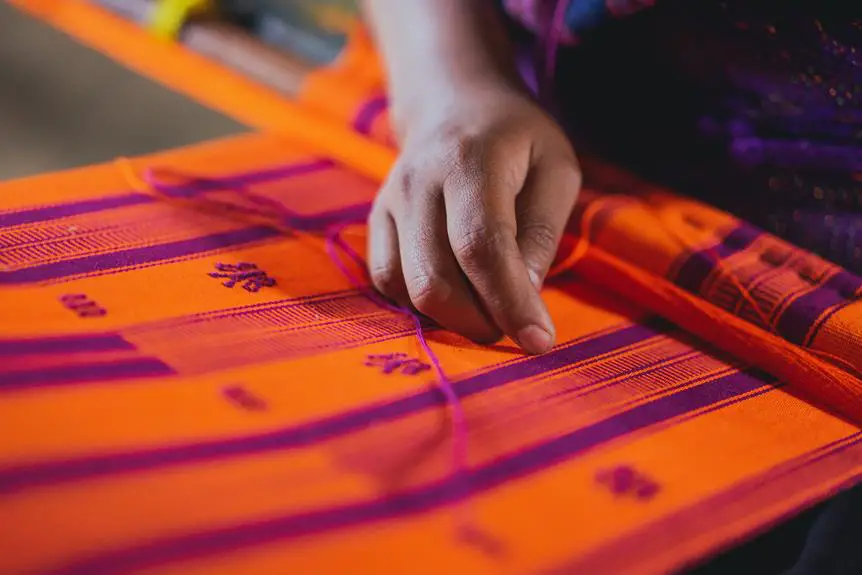When it comes to achieving intricate designs and vibrant colors on rotary fabrics, screen printing certainly holds its own. This versatile method offers precise detail and consistent results, making it a top choice for those seeking mastery in fabric printing.
In this exploration, we'll delve into the benefits, challenges, and best practices of screen printing on rotary fabrics, equipping you with the knowledge to make informed decisions for your projects. Whether you're a seasoned professional or an aspiring expert in the field, understanding the nuances of screen printing for rotary fabrics is essential for achieving exceptional results.
Key Takeaways
- Screen printing offers durability and vibrant color options for rotary fabrics.
- Challenges of screen printing on rotary fabrics include ink penetration challenges, uneven ink penetration, ink bleed or spreading, incomplete ink coverage, color inconsistency, fabric distortion or stretching, alignment and registration challenges, fabric tension, and registration marks.
- Factors affecting screen printing on rotary fabrics include ink adhesion, utilizing the right ink and additives, testing different ink formulations and curing methods, design intricacy, meticulous screen preparation, accurate registration, and paying attention to screen tension and mesh count.
- Best practices for screen printing on rotary fabrics include rotary fabric preparation, ensuring fabric is clean and free from contaminants, using specialized fabric pre-treatment techniques, color mixing techniques, utilizing precise color mixing ratios, and conducting thorough testing on sample fabrics.
Benefits of Screen Printing for Rotary Fabrics
Screen printing offers durability and vibrant color options for rotary fabrics, making it an ideal choice for achieving intricate designs and long-lasting results. When it comes to ink adhesion, screen printing excels in creating a strong bond between the ink and the fabric. This ensures that the designs remain vivid and sharp even after multiple washes, making it a preferred choice for items like clothing and home textiles.
The technique allows for precise control over the ink application, resulting in crisp and intricate designs that are difficult to achieve with other printing methods. This level of design intricacy is especially beneficial for intricate patterns and detailed artwork on rotary fabrics.
The ability to use a wide range of ink types, including specialty inks like metallic and fluorescent, further enhances the design possibilities, allowing for unique and eye-catching creations.
Whether it's for fashion, home decor, or other fabric-based applications, screen printing offers the durability and design intricacy necessary for high-quality, long-lasting results.
Challenges of Screen Printing on Rotary Fabrics
When screen printing on rotary fabrics, you may encounter challenges related to ink penetration, which can affect the overall quality and durability of the print.
Additionally, maintaining precise alignment and registration of the design on the fabric presents another significant challenge that requires careful attention and expertise.
These challenges can impact the final outcome and require specific techniques and tools to overcome effectively.
Ink Penetration Challenges
You may encounter challenges with ink penetration when screen printing on rotary fabrics. Proper fabric preparation is crucial to ensure successful ink penetration and achieve high-quality results. Here are some common challenges associated with ink penetration when screen printing on rotary fabrics:
| Challenges | Solutions |
|---|---|
| Uneven ink penetration | Ensure proper tension and alignment of the screen. |
| Ink bleed or spreading | Use appropriate mesh count and adjust squeegee pressure. |
| Incomplete ink coverage | Opt for pre-treating the fabric to improve ink adhesion. |
| Color inconsistency | Perform thorough color mixing and testing. |
| Fabric distortion or stretching | Use proper fabric tensioning techniques during printing. |
Addressing these challenges through meticulous fabric preparation and printing techniques can significantly improve ink penetration and overall print quality on rotary fabrics.
Alignment and Registration
To achieve precise alignment and registration when screen printing on rotary fabrics, meticulous attention to detail is crucial for successful results. When dealing with the challenges of alignment and registration accuracy, consider the following techniques:
- Fabric Tension:
Ensure the fabric is uniformly tensioned to prevent distortion during the printing process.
Use proper stretching equipment to achieve consistent tension across the fabric.
Regularly monitor and adjust the tension to maintain accuracy throughout the printing.
- Registration Marks:
Implement clear and strategically placed registration marks on the fabric to guide the alignment of different colors or design elements.
Utilize high-contrast marks that are easily visible during the printing process.
Verify the accuracy of the registration marks to ensure precise alignment of the print layers.
Factors Affecting Screen Printing on Rotary Fabrics
Understanding the various factors that can affect screen printing on rotary fabrics is crucial for achieving high-quality results in your printing process. Factors such as ink adhesion and design intricacy play a significant role in determining the success of your screen printing techniques on rotary fabrics. Here are some key factors to consider:
| Factors | Techniques |
|---|---|
| Ink Adhesion | Utilizing the right ink and additives to improve adhesion to the fabric is essential. Testing different ink formulations and curing methods can help achieve optimal adhesion. |
| Design Intricacy | Complex designs with fine details require meticulous screen preparation and accurate registration to ensure the design is accurately transferred onto the fabric. Pay close attention to screen tension and mesh count to accommodate intricate designs. |
Considering these factors and implementing appropriate techniques will contribute to the successful execution of screen printing on rotary fabrics, resulting in high-quality, vibrant prints with excellent design clarity.
Best Practices for Screen Printing on Rotary Fabrics
With a focus on optimizing ink adhesion and mastering design intricacy, best practices for screen printing on rotary fabrics ensure high-quality results.
To achieve optimal outcomes, consider the following best practices:
- Rotary Fabric Preparation
- Ensure the rotary fabric is clean and free from any contaminants before printing to promote proper ink adhesion.
- Use specialized fabric pre-treatment techniques to enhance the fabric's receptivity to the ink, improving color vibrancy and durability.
- Color Mixing Techniques
- Utilize precise color mixing ratios to achieve consistent and accurate color reproduction on rotary fabrics.
- Conduct thorough testing of color mixtures on sample fabrics to assess color accuracy and vibrancy before full-scale production.
When preparing rotary fabrics for screen printing, it's vital to ensure that the fabric surface is adequately primed for ink adhesion. Additionally, employing meticulous color mixing techniques is crucial for achieving the desired color accuracy and vibrancy.
Rotary Fabric Considerations for Screen Printing
When considering screen printing on rotary fabrics, it's essential to take into account the fabric's compatibility with the process.
Additionally, challenges related to ink adhesion should be carefully evaluated to ensure the desired print quality.
Moreover, the intricacy of the design must be taken into consideration, as it can impact the feasibility of screen printing on rotary fabrics.
Rotary Fabric Compatibility
Consider the fabric weight and composition when selecting a design for screen printing on rotary fabrics.
- Fabric Weight:
- Lighter fabrics may require special attention to prevent ink bleed and smudging.
- Heavier fabrics may need a thicker ink deposit for proper coverage.
- Fabric Composition:
- Natural fibers like cotton may offer better ink adhesion compared to synthetic materials.
- Blended fabrics may require testing to ensure ink adhesion and color vibrancy.
It is essential to match the printing techniques with the rotary fabric's characteristics to achieve optimal results. Factors such as ink adhesion and design intricacy play a crucial role in determining the compatibility of screen printing with rotary fabrics. By carefully considering these elements, you can enhance the effectiveness of screen printing on rotary fabrics.
Ink Adhesion Challenges
Facing ink adhesion challenges when screen printing on rotary fabrics requires understanding the fabric's properties and adjusting the printing process accordingly.
Rotary fabrics often have a textured or uneven surface, which can pose challenges for ink adhesion. To address this, thorough fabric preparation is essential. Preparing the fabric by ensuring it's clean and free from any contaminants, such as oils or dust, is crucial. Additionally, using a pre-treatment or primer specifically designed for rotary fabrics can improve ink adhesion.
Adjusting the printing process parameters, such as squeegee pressure and ink viscosity, can also enhance ink adhesion on rotary fabrics. Conducting thorough testing and experimentation with different fabric preparation techniques and printing parameters is necessary to achieve optimal ink adhesion results on rotary fabrics.
Design Intricacy Limitations
To achieve successful screen printing on rotary fabrics with intricate designs, carefully evaluate the fabric's texture and surface properties to determine the most suitable printing approach. When considering design complexity and fabric compatibility, keep in mind the following:
- Design Complexity
- Fine details and intricate patterns may require additional printing considerations to ensure accurate reproduction on rotary fabrics.
- Complex designs may necessitate specialized techniques such as halftone printing to maintain design intricacy.
- Fabric Compatibility
- The fabric's weave, composition, and surface texture play a crucial role in determining the suitability of screen printing for intricate designs.
- Different fabrics may require specific ink formulations and pre-treatment processes to optimize ink adhesion and registration accuracy.
Innovations in Screen Printing for Rotary Fabrics
When screen printing on rotary fabrics, you can achieve innovative designs and patterns that were previously difficult to reproduce. Thanks to innovative technology, screen printing for rotary fabrics has seen significant advancements in recent years.
One such innovation is the development of high-resolution rotary screens, which allow for intricate details and complex patterns to be printed with exceptional precision. These screens have revolutionized fabric printing trends by enabling the reproduction of fine lines, small text, and elaborate designs that were once challenging to achieve through traditional screen printing methods.
Additionally, advancements in ink formulations have expanded the color palette available for rotary fabric printing, offering a broader range of vibrant and long-lasting hues.
Furthermore, the integration of digital processes with traditional screen printing techniques has opened up new possibilities for creating custom designs and personalized patterns on rotary fabrics.
These innovations have propelled screen printing to the forefront of fabric printing technology, providing textile designers and manufacturers with the tools to unleash their creativity and meet the demands of the ever-evolving fashion and interior design industries.
Comparison of Screen Printing With Other Rotary Fabric Techniques
In comparing screen printing with other rotary fabric techniques, consider the versatility and precision that high-resolution rotary screens offer for achieving intricate designs and patterns.
When comparing screen printing to other rotary fabric techniques, it's essential to highlight the unique qualities and benefits of each method. Here are some key points to consider:
- Screen Printing:
- High level of detail and precision achievable
- Versatile in terms of colors and types of fabric
- Other Rotary Fabric Techniques:
- Digital Printing:
- Offers exceptional color vibrancy and detail
- Well-suited for complex, multicolored designs
- Roller Printing:
- Known for its high-speed production capabilities
- Ideal for large-scale fabric runs with repeating patterns
When comparing these techniques, it's important to consider factors such as quality, durability, and the specific requirements of the intended design. Each method has its strengths and limitations, and selecting the most suitable technique depends on the desired outcome and production needs.
Tips for Successful Screen Printing on Rotary Fabrics
For successful screen printing on rotary fabrics, use the appropriate mesh count for achieving fine details and intricate designs. When preparing for screen printing on rotary fabrics, consider using a mesh count of 155-196 for light-colored inks and 196-305 for dark-colored inks. This will ensure that the ink is properly transferred onto the fabric, resulting in sharp and detailed prints.
Additionally, pay close attention to fabric tensioning. Proper tensioning of the fabric on the rotary screen printing press is crucial for achieving consistent and high-quality prints. Inadequate tension can lead to registration issues and uneven ink deposits. Ensure that the fabric is uniformly tensioned across the entire printing area to avoid any distortions or imperfections in the printed design.
Prioritize thorough printing preparation by meticulously cleaning the screens and ensuring that the design is properly exposed onto the mesh for optimal results. By adhering to these tips for successful screen printing on rotary fabrics, you can produce impeccable prints with precision and clarity.
Frequently Asked Questions
What Are the Environmental Impacts of Screen Printing on Rotary Fabrics?
Screen printing on rotary fabrics can have significant environmental impact due to water and energy use, as well as chemical waste. Sustainable alternatives such as digital printing or eco-friendly dyes offer more environmentally friendly options.
Are There Any Special Considerations for Screen Printing on Stretchy or Elastic Rotary Fabrics?
When screen printing on stretchy fabrics, consider ink adhesion and color registration. Fabric distortion may occur, affecting print quality. Use proper tension and stretch control to achieve optimal results.
Can Screen Printing Be Used on Rotary Fabrics With Intricate or Detailed Designs?
Yes, screen printing techniques can be used on rotary fabrics with intricate or detailed designs. However, consider the environmental impact, stretchy fabric challenges, cost comparison, and certification regulations, especially for children's clothing.
How Does Screen Printing on Rotary Fabrics Compare to Digital Printing in Terms of Cost and Quality?
When comparing screen printing on rotary fabrics to digital printing, it's important to consider cost and quality. Screen printing may offer a cost advantage for large runs, while digital printing can provide higher quality for intricate designs.
Are There Any Regulations or Certifications to Consider When Screen Printing on Rotary Fabrics, Such as for Children's Clothing or Eco-Friendly Textiles?
When screen printing on rotary fabrics for children's clothing or eco-friendly textiles, it's crucial to consider regulations and certifications. Look for standards related to color fastness, fabric durability, and eco-friendly materials to ensure compliance and quality.
- Can You Get Organza Wet? - April 23, 2024
- Why Is Organza so Popular? - April 23, 2024
- What Do You Wear With Organza? - April 23, 2024








